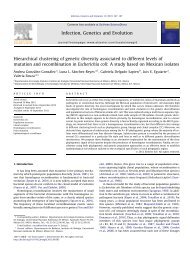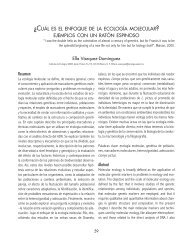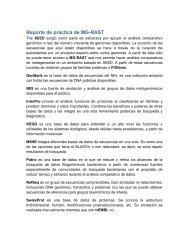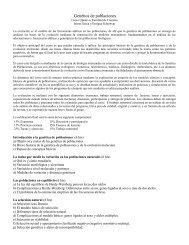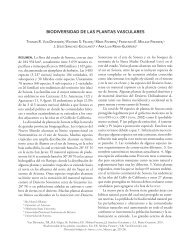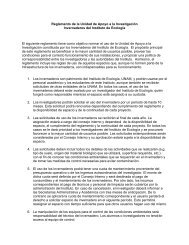4VariacionEvolucion2b copy.pdf - Instituto de Ecología
4VariacionEvolucion2b copy.pdf - Instituto de Ecología
4VariacionEvolucion2b copy.pdf - Instituto de Ecología
- No tags were found...
Create successful ePaper yourself
Turn your PDF publications into a flip-book with our unique Google optimized e-Paper software.
Table 1 Database of the review on life history traits and diversity obtained with RAPD, AFLP and ISSR markers. Number of studies, meanand standard <strong>de</strong>viation are given for each of four sampling strategy parameters: number of populations, number of plants per population,maximum geographical distance between sampled populations and number of polymorphic markers, and for three genetic parameters: amova<strong>de</strong>rivedF ST, Nei’s G ST, and mean within-population diversity, H popParameterRAPDNMean ± SDAFLPNMean ± SDISSRNMean ± SDPopulations 158 7.9 ± 6.4 27 14.0 ± 14.8 13 10.3 ± 7.7Plants 156 18.5 ± 14.6 27 14.5 ± 9.0 12 17.5 ± 8.0Distance (km) 152 956 ± 1880 26 1547 ± 2664 12 1315 ± 2335Markers 157 72.3 ± 59.5 27 238.1 ± 277.9 13 54.9 ± 19.7Φ ST116 0.34 ± 0.24 21 0.35 ± 0.18 9 0.35 ± 0.25G ST46 0.27 ± 0.21 12 0.21 ± 0.14 6 0.34 ± 0.29H pop60 0.22 ± 0.12 13 0.23 ± 0.08 4 0.22 ± 0.08is equivalent to the weighted average of F STfor all alleles(Nei 1973). In most cases, the Hamrick & Godt approachwith calculations carried out separately for each locusappears to have been used, but occasionally the parameterswere first averaged across loci instead. For SMM-basedcalculations, R STwas introduced as a replacement for theconventional la isoenzimas!F ST(Slatkin 1995). The R STestimator is eitherunstandardized, i.e. calculated from the raw variancesof allele lengths (Michalalakis & Excoffier 1996) orstandardized for each locus by division through the overallstandard <strong>de</strong>viation in repeat lengths (Goodman 1997).These diversity parameters, F STand R ST, were treatedseparately in the data compilation since they often differconsi<strong>de</strong>rably when calculated on the same data set(Raybould et al. 1998; Reusch et al. 2000).analyses were performed mostly for studies based onRAPD, AFLP and STMS while those based on ISSR weretoo few. Pearson correlation coefficients were used to estimaterelationships among the population genetics parameters.Regression analyses were carried out using the populationgenetics parameters as <strong>de</strong>pen<strong>de</strong>nt variables and the samplingstrategy parameters as in<strong>de</strong>pen<strong>de</strong>nt variables. Effects of lifehistory traits were investigated using these as group variablesin single-factor analyses of variance for RAPD and STMS,with H pop, H E, H O, Φ ST, G STand F STas <strong>de</strong>pen<strong>de</strong>nt variables.se comportan <strong>de</strong> manera parecida entre ellos y conpero son dominantes, y solo tienen dos“alelos” presencia y ausencia!ResultsSampling strategiesMean number of populations, plants per population,



